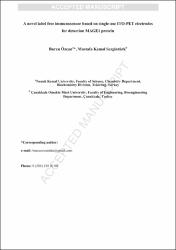| dc.contributor.author | Özcan, Burcu | |
| dc.contributor.author | Sezgintürk, Mustafa Kemal | |
| dc.date.accessioned | 2022-05-11T14:30:56Z | |
| dc.date.available | 2022-05-11T14:30:56Z | |
| dc.date.issued | 2017 | |
| dc.identifier.issn | 1572-6657 | |
| dc.identifier.issn | 1873-2569 | |
| dc.identifier.uri | https://doi.org/10.1016/j.jelechem.2017.03.036 | |
| dc.identifier.uri | https://hdl.handle.net/20.500.11776/7241 | |
| dc.description.abstract | This study is aimed to design a label free biosensor based on transparent ITO-PET (Indium tin oxide-polyethylene terephthalate) electrode to determine MAGE1 protein. Firstly, indium tin oxide (ITO) electrodes were modified with NH4OH/H2O2/H2O to obtain the OH groups on the surface. Later, the surface of ITO electrodes were treated with 3-glycidoxypropyltriethoxysilane (3-GOPE). After SAM formation, anti-MAGE1 protein was covalently immobilized on modified ITO electrodes. The parameters such as SAMs concentration, the concentration and incubation time of anti-MAGE1 solution were optimized. For determining the immobilization steps and optimization of the biosensor, electrochemical impedance spectroscopy (EIS) and cyclic voltammetry (CV) were utilized. To determine analytical characterization of designed biosensor; linear range, repeatability, reproducibility, regeneration processes were studied. In optimum conditions, the linear range of the biosensor was determined as 0.01 pg-1.28 pg mL(-1). Square wave voltammetry technique was applied to the biosensor. These steps were realized in K-3[Fe (CN)(6)]/K/4[Fe(CN)(6)] redox probe. Moreover, Single frequency technique was used to understand the interaction between antiMAGE-1 and MAGE-1 protein. This step was realized in pH 7 phosphate buffer. And also, shelf life of designed biosensor was investigated. SEM (Scanning Electron Microscope) technique was used to determine the morphology of the surface in every step. The other important parameter for this study was Kramer's Kronig transform. It is used to determine whether the impedance spectra of the designed biosensor are affected from the deviation obtained because of external factors. Lastly, the designed biosensor was applied to real human serum and the results were compared with ELISA (Enzyme-Linked ImmunoSorbent Assay) test. (C) 2017 Elsevier B.V. All rights reserved. | en_US |
| dc.description.sponsorship | TUBITAK (The Scientific and Technological Research Council of Turkey)Turkiye Bilimsel ve Teknolojik Arastirma Kurumu (TUBITAK) [113 Z 678] | en_US |
| dc.description.sponsorship | This work was funded by TUBITAK (The Scientific and Technological Research Council of Turkey), (Project Number: 113 Z 678), this assistance is greatly acknowledged. | en_US |
| dc.language.iso | eng | en_US |
| dc.publisher | Elsevier Science Sa | en_US |
| dc.identifier.doi | 10.1016/j.jelechem.2017.03.036 | |
| dc.rights | info:eu-repo/semantics/closedAccess | en_US |
| dc.subject | ITO-PET electrodes | en_US |
| dc.subject | MAGE1 | en_US |
| dc.subject | Cyclic voltammetry (CV) | en_US |
| dc.subject | Electrochemical impedance spectroscopy (EIS) | en_US |
| dc.subject | Label free immunosensor | en_US |
| dc.subject | T-Lymphocytes | en_US |
| dc.subject | Gene | en_US |
| dc.subject | Expression | en_US |
| dc.subject | Biosensor | en_US |
| dc.subject | Antigen | en_US |
| dc.subject | Melanoma | en_US |
| dc.subject | Codes | en_US |
| dc.title | A novel label free immunosensor based on single-use ITO-PET electrodes for detection MAGE1 protein | en_US |
| dc.type | article | en_US |
| dc.relation.ispartof | Journal of Electroanalytical Chemistry | en_US |
| dc.department | Fakülteler, Fen Edebiyat Fakültesi, Kimya Bölümü | en_US |
| dc.authorid | 0000-0002-5123-5972 | |
| dc.identifier.volume | 792 | en_US |
| dc.identifier.startpage | 31 | en_US |
| dc.identifier.endpage | 38 | en_US |
| dc.institutionauthor | Özcan, Burcu | |
| dc.relation.publicationcategory | Makale - Uluslararası Hakemli Dergi - Kurum Öğretim Elemanı | en_US |
| dc.authorscopusid | 56106034900 | |
| dc.authorscopusid | 6506764918 | |
| dc.authorwosid | Özcan, Burcu/AAY-1451-2021 | |
| dc.authorwosid | Sezgintürk, Mustafa Kemal/AAY-1439-2021 | |
| dc.identifier.wos | WOS:000403634500005 | en_US |
| dc.identifier.scopus | 2-s2.0-85015992752 | en_US |



















